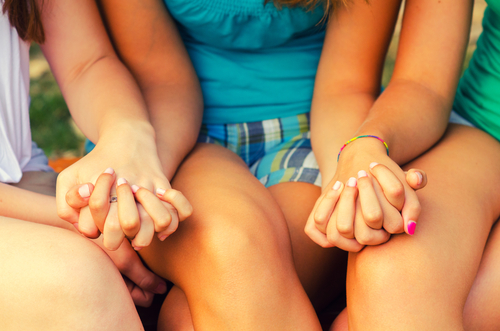As a kid, I was deeply invested in the lives of a group of fictional baby-sitters.
In the nebulous landscape of my preadolescence, the Baby-Sitters Club stayed a constant. If nothing else, I knew that on Mondays, Wednesdays, and Fridays at 5:30 EST, the baby-sitters were gathering to field calls from the parents of Stoneybrook, Connecticut. Mary-Anne would meticulously record every baby-sitting job in the Record Book. Dawn would wax poetic about California. Claudia would disappear into the far reaches of her closet and return with two bags of chips and three packs of Reese’s and half a dozen creme brulees, plus a butane torch to caramelize the tops. Okay, maybe not, but Kristy would probably be wearing a turtleneck.
In today’s internet and social media age, the Baby-Sitters Club series is admittedly a bit dated (case in point—they could now get a website, which would probably eliminate the need for tri-weekly meetings). But nevertheless, the Baby-Sitters Club books were meaningful to me as a kid. What I loved the most was the relationships between the baby-sitters themselves. I loved the intricacies of their friendships, the different dynamics between different girls, the shared history. I loved that it wasn’t always simple between them. They didn’t always see eye to eye. Sometimes they fought, sometimes they fell apart, but they’d always come back together. Ultimately, they supported one another.
In junior high and high school, I was lucky enough to have a supportive friend group of my own. Obviously this didn’t come solely from the influence of Ann M. Martin’s creative oeuvre, but the representation of friendship in this series was undoubtedly positive reinforcement at that time of my life. On the pages of these books were girls who supported one another, who celebrated each other’s differences and held up each other up. So often, we see stories that fall back on the notion of girls being pitted against each other, girls feeling threatened by one another, girls vying for the attentions of the same guy. Showing healthy female friendships in YA is absolutely beneficial to young readers. I was one of those readers myself, and I craved stories that went beyond the outdated “mean girls” tropes. I can’t tell you how satisfying it was for me as a kid to watch Legally Blonde and see Elle and Vivian, nemeses as first, eventually kick waste-of-time boyfriend Warner to the curb and become best friends. I loved watching the evolution of Rory and Paris’s friendship on Gilmore Girls, the initial antagonism between them transforming over time into mutual respect and admiration.
I graduated from the Baby-Sitters Club series to books like Jaclyn Moriarty’s The Year of Secret Assignments, and Ann Brashares’s The Sisterhood of the Traveling Pants. These are stories where girls looked out for each other, where their friendships are just as important as their romantic relationships, just as meaningful and valid, if not more so. I’m the first to admit, I love a good romance. I love the meetcutes, the getting-to-know-you, the complications, the ultimate coming together. But I love friendship stories just as much—ones that explore the idea of platonic love, which can share so many of those same aspects, and can be every bit as significant and life-changing, if not more so. As a shy, awkward kid (now turned awkward adult) who had approximately zero dating experiences in high school, I love teen stories that present the idea that the Love Interest—either securing one, or being one—is not the end all and be-all of high school existence. Since, you know, it’s not the end-all and be-all of existence in general, either.
Of course it doesn’t have to be an either/or scenario. After all, Elle Woods got a new best friend PLUS Luke Wilson, and managed to graduate top of her class in law school. Romance and friendship can obviously co-exist in fiction as in life. But I think stories that balance both are valuable for girls, stories with meaningful friendships, where finding The One doesn’t necessarily equate to finding a significant other. Platonic love expands the very concept of The One, with the notion that there can be more than one kind of The One.
In my novel This Adventure Ends, Sloane has never had a close group of friends. When she moves with her family from New York City to Florida for her senior year, she expects more of the same. That is, until she meets Vera—the best friend soulmate she didn’t even think existed. The dynamic between Sloane and Vera—Sloane slowly learning what it means to have a friend and to be a friend—is one of my favorite aspects of the book. Sloane comes to realize the intricacies of friendship, how it can be as complicated as romantic love, as murky and potentially heartbreaking, but ultimately so, so rewarding. The interplay between Sloane and Vera and their larger friend group as a whole—Vera’s other best friend Aubrey, their childhood friend Remy, and Vera’s brother Gabe—is complex. But they’re a group of people who have each other backs, who support each other through ups and down—not unlike my favorite group of teen baby-sitters from back in the day.
From the Baby-Sitters to besties with magically fitting jeans to former rivals turned dear friends, I really appreciate representation of positive, realistic female friendships in fiction. I think they’re valuable stories to share with young readers, in the spirit of Leslie Knope’s Galentine’s Day—ladies celebrating ladies.
(It’s wonderful, and it should be a national holiday.)
featured image via Shutterstock
Emma Mills is a debut author, better known to her subscribers as vlogger Elmify, co-creator and co-host of the “life skills” channel How to Adult.
—The Mary Sue has a strict comment policy that forbids, but is not limited to, personal insults toward anyone, hate speech, and trolling.—
Follow The Mary Sue on Twitter, Facebook, Tumblr, Pinterest, & Google+.









Published: Oct 4, 2016 11:06 am